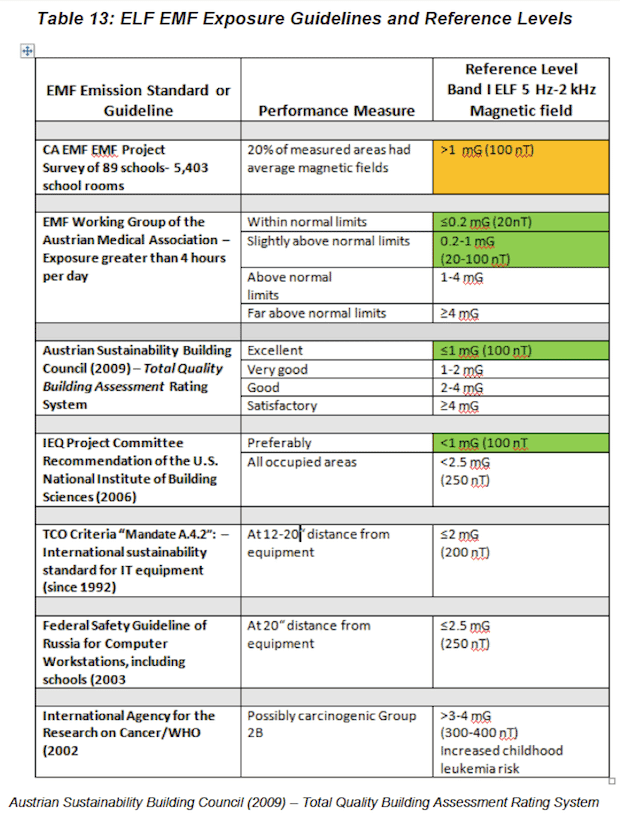EMF in Schools, CHPS Takes a Stand

EMF in Schools – Collaboration for High Performance Schools
For many years CHPS has been a leader in identifying sustainable and healthy building trends for school buildings. Long before LEED for Schools, there was the Collaboration for High Performance Schools Criterion and scorecard. This rating system has been tested and proven effective, and recently has taken a stand to reduce EMF in schools.

CHPS Adopts EMF Credits
We are routinely called in by parents, teachers, and administrators who are concerned about EMF in schools. This usually happens because someone realizes a classroom is right by a cell tower, power line or transformer, or someone has “a meter” and found alarming levels they would like to have confirmed and/or mitigated. We’ve done EMF inspections for private schools and public schools, kindergarten and university classrooms, even a local school district administrative building (cell antennas on rooftop). There is obviously concern among citizens and a growing body of scientific evidence linking EMF to health effects.
EMF in Schools – CHPS verse LEED
I was confident when we applied for an Innovation in Design (ID) point for a LEED Homes Platinum project following low-EMF design and construction best practices. This healthy home remodel project implemented far more than the average number of precautionary approaches and mitigation strategies to limit occupant exposure to EMF and RF. We wrote a strong EMF credit application with language in LEED-speak, but the IEQ TAG, a group more concerned with air quality and day lighting, denied the EMF credit application despite our appeal. To this day, the USGBC has not accepted any EMF reduction strategies in any of the LEED rating systems.

CHPS Core Criteria Support Low EMF in Schools
Fortunately, we have competing rating systems for schools. With help from researchers and practitioners from around the world, including yours truly, the new CHPS Core Criterion include several opportunities for schools to garner points for reducing EMF exposure.
CHPS EMF Credits
EQc15.1

CHPS EQ 15.1 Low-EMF Wiring
Environmental Quality (EQ) credit 15.1 awards up to two points for following wiring best practices. This credit focuses specifically on reducing elevated magnetic fields created by wiring errors. Here it reads:
“EQ 15.1 No net current magnetic fields – Correct school wiring
The wiring in all school rooms shall be compliant with the currently adopted US National Electrical Code (NEC) in the local jurisdiction, and applicable state electrical code.
All school rooms shall be free of the following common wiring errors:
- Improperly wired sub-panels (neutral-to-ground bond)
- Incorrect three-way switch wiring
- Incorrect wiring of switched outlet circuits
- Neutrals from separate branch circuits that are connected anywhere beyond the panel of origin for the circuits
- Neutral-ground shorts (intentional or inadvertent) anywhere in the system
Wiring shall be checked in each room and the ELF magnetic field exposure measured levels (tRMS) shall comply with 1 mG (100 nT) in new construction and 2 mG (200 nT) in existing school modernization. See the Austrian Sustainability Building Council (2009) – Total Quality Building Assessment Rating System as shown in Table 13 below.

Table 13 EMF Exposure Guidelines and Reference Levels

CHPS EQ 15.2 Low-EMF Best Practices
EQc15.2 awards up to 2 points for choosing a variety of low-EMF best practices. These credits involve reducing ambient levels of radio frequency (RF) radiation, although the credit title is still highlighting the broader spectrum of “EMF.” Here are the detailed credit requirements:
“EQ 15.2.1 Low EMF Best Practices for Computers
The district or equivalent governing body for a private school shall pass a resolution requiring:
- Desktop computers, laptops, notebooks, and tablets be operated on a desk; operation of these devices on an occupant’s lap or body is prohibited; computer workstation equipment must be greater than 2 feet from occupants.
- Desktop computers, laptops, notebooks, and tablets be TCO-certified or laboratory tested to meet TCO Criteria “Mandate A.4.2” for EMF emissions.
- Laptops or notebooks have an Ethernet port and a physical switch to conveniently disable all wireless radios at once and an adaptor with a 3-pin plug.
- Only tablets that support a USB Ethernet adaptor for a wired network connection; operate tablets only in battery mode and not when plugged in. AND
EQ 15.2.2 Wired local area network (LAN) to reduce radio-frequency (RF) EMF
- Install a wired local area network (LAN) for Internet access throughout the school. Provide wired network connections for desktop computers, laptops, notebooks, and tablets. All wireless transmitters shall be disabled on all WiFi enabled devices. Provide wired input devices for computer workstations. OR
EQ 15.2.3 Wired Phones to reduce RF EMF in classroom
- Install easily accessible hard-wired phones for teacher and student use and prohibit installation and use of standard DECT cordless phones and cordless phones operating at 2.4 GHz and 5.8 GHz unless they have been laboratory tested to demonstrate that the cordless phone base station and handsets (whether placed in the charging station or not) do not emit RF EMF emissions in standby mode.
- Prohibit the use of cell phones and other personal electronic devices in instructional areas / classrooms. Additionally, they shall be required to be powered off or be in airplane mode (sleep mode is not sufficient) except during fire-life-safety drills and incidents.
CHPS Online Rating System for Schools
These credit requirements are based on sound science and years of trial and error in the field. They make sense, are relatively easy to implement, and I hope all schools move in this direction in coming years. I’m grateful to CHPS for taking the stand that the USGBC did not. Children deserve low-EMF in schools.
To read the full CHPS National Core Criteria or California-Specific Credits:
- 2014 CA-CHPS – The fourth edition of the original green schools rating system raises the bar on indoor environmental quality.
- US-CHPS – Based on the Core Criteria, US-CHPS is available for those schools located in the remaining 37 states and the District of Columbia that do not currently have a custom CHPS Criteria.



